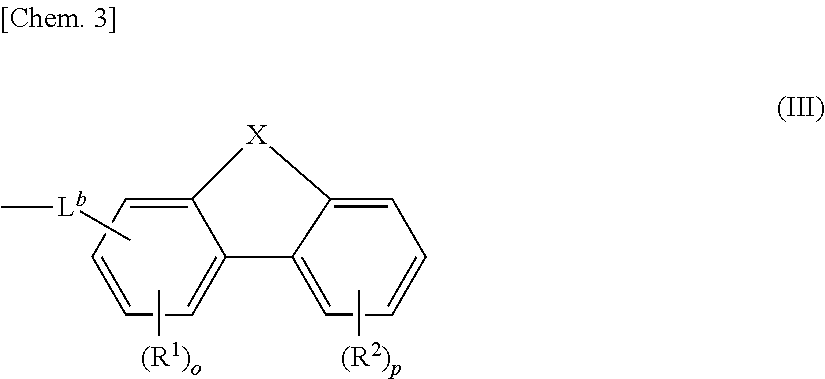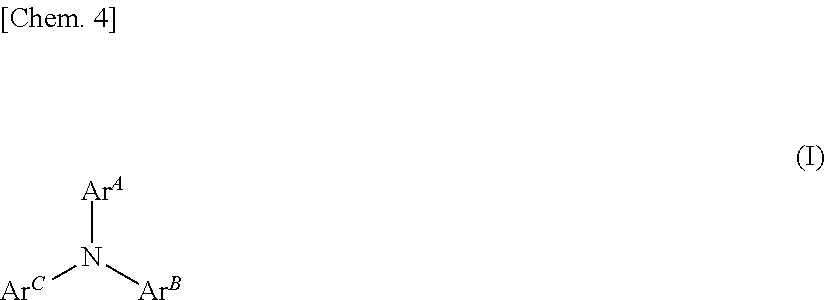Aromatic amine derivative, and organic electroluminescent element comprising same
a technology of organic electroluminescence and amine, which is applied in the direction of triarylamine dyes, organic chemistry, luminescent compositions, etc., can solve the problems of increasing driving voltage, reducing luminous efficiency, and changing luminescent color, so as to reduce the driving voltage of the organic el device, the effect of improving luminous efficiency and device li
- Summary
- Abstract
- Description
- Claims
- Application Information
AI Technical Summary
Benefits of technology
Problems solved by technology
Method used
Image
Examples
synthesis example 1
Synthesis of Intermediate 1
[0174]Under an argon atmosphere, 1,200 mL of toluene and 650 mL of a 2 mol / L aqueous solution of sodium carbonate were added to 70 g of 1,3,5-tribromobenzene, 54 g of phenylboronic acid, and 10.2 g of tetrakis(triphenylphosphine)palladium, and then the mixture was heated for 10 hours while being refluxed.
[0175]Immediately after the completion of the reaction, the resultant was filtrated, and then the aqueous layer was removed. The organic layer was dried with sodium sulfate, and was then concentrated. The residue was purified by silica gel column chromatography. Thus, 23.9 g of a white crystal were obtained. The white crystal was identified as 3,5-diphenyl-1-bromobenzene by field desorption mass spectral (hereinafter referred to as “FD-MS”) analysis.
[0176]Under an argon atmosphere, 250 mL of anhydrous tetrahydrofuran were added to 23.9 g of 3,5-diphenyl-1-bromobenzene, and then the mixture was stirred at −40° C. During the stirring, 60 mL of a 1.6 mol / L so...
synthesis example 2
Synthesis of Intermediate 2
[0179]In a stream of argon, 23 g of iodine, 9.4 g of periodic acid dihydrate, 42 mL of water, 360 mL of acetic acid, and 11 mL of sulfuric acid were added to 55 g of 2-bromo-9,9-dimethylfluorene, and the mixture was stirred at 65° C. for 30 minutes and was then subjected to a reaction at 90° C. for 6 hours. The reactant was poured into ice water, followed by filtering. The resultant was washed with water, and then washed with methanol, whereby 61 g of a white powder were obtained. The white powder was identified as the intermediate 2 by FD-MS analysis.
synthesis example 3
Synthesis of Intermediate 3
[0180]Under an argon atmosphere, 300 mL of toluene and 150 mL of a 2 mol / L aqueous solution of sodium carbonate were added to 28.3 g of 4-iodobromobenzene, 22.3 g of dibenzofuran-4-boronic acid, and 2.31 g of tetrakis(triphenylphosphine)palladium, and then the mixture was heated for 10 hours while being refluxed.
[0181]Immediately after the completion of the reaction, the resultant was filtrated, and then the aqueous layer was removed. The organic layer was dried with sodium sulfate, and was then concentrated. The residue was purified by silica gel column chromatography. Thus, 26.2 g of a white crystal were obtained. The white crystal was identified as the intermediate 3 by FD-MS analysis.
PUM
| Property | Measurement | Unit |
|---|---|---|
| transmittance | aaaaa | aaaaa |
| work function | aaaaa | aaaaa |
| work function | aaaaa | aaaaa |
Abstract
Description
Claims
Application Information
 Login to View More
Login to View More - R&D
- Intellectual Property
- Life Sciences
- Materials
- Tech Scout
- Unparalleled Data Quality
- Higher Quality Content
- 60% Fewer Hallucinations
Browse by: Latest US Patents, China's latest patents, Technical Efficacy Thesaurus, Application Domain, Technology Topic, Popular Technical Reports.
© 2025 PatSnap. All rights reserved.Legal|Privacy policy|Modern Slavery Act Transparency Statement|Sitemap|About US| Contact US: help@patsnap.com



